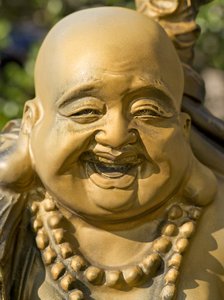 Submitted by Claire de Lune on
Submitted by Claire de Lune on

One of the most iconic images of Buddhism is surely that of the Buddha sitting silently under a tree, with his eyes half-closed, while beaming the most beautiful, kind and understanding smile ever. So enduring is this depiction of deep peace and composure, that the Buddha, be it in the form of statues or pictures, is the most reproduced image in the world. It is appreciated not only by Buddhists, but by people from various cultural walks of life – to the extent that Buddha images have become home decor must-haves for many!
Yet, as alluring as the Buddha’s smile is, many of us are still puzzled by it, for it presents many a mystery… Why is the Buddha smiling? What is he smiling about? How did he manage to attain the True Happiness that his smile represents? Perhaps most importantly, can we smile a similar smile too? Of course we can! Is that not the deeper reason why we venerate the Buddha – so as to draw inspiration from him, so as to emulate his perfect compassion and wisdom? The good news is that ever since the Buddha smiled his ‘magic’ smile, he shared on how we can too.
The Buddha smiles because he has made peace, not only with himself, but with the rest of the world too. This should not be mistaken as constant abiding in a state of complacent inactivity, for Buddhahood is realised through the active perfection of compassion to benefit all beings, and of the perfection of wisdom to know how to best help them. What the eternally seated Buddha represents is the state of enlightened bliss that the Buddha abides in – even as he does his best, which is whatever is necessary in the moment, to guide beings to the same enlightenment (synonymous with True Happiness).
The secret of the Buddha’s smile lies in the mastery of his mind – through the practice of meditation. The pose we see Buddha images in is usually that of the Buddha in the classic meditation posture. There are many forms of meditation taught today, with just as many varied purposes as techniques, just as in the Buddha’s time. The Buddha himself mastered meditation from the greatest meditation teachers available then – before realising their methods were inadequate for realising enlightenment.
What then, sets the Buddha’s meditation methods aside? The Buddha too taught many forms of meditation, as part of the Noble Eightfold Path to liberation. In this sense, the Buddha never really taught any meditation technique for its own sake, as the long-term goal is always nothing less than perfect enlightenment. Buddhist meditation thus should ideally not be practised merely as a feel-good relaxation exercise, as if one is doing yoga only for fitness. It would be a great pity to shortchange ourselves of meditation’s full benefits! However, it is nevertheless true that what the Buddha taught can still benefit many who do not yet aspire for enlightenment. All in good time?
A good example of a Buddhist meditation method suitable for all, be one Buddhist or not, is the practice of loving-kindness (Metta) meditation, whereby one systematically cultivates thoughts and energy of loving-kindness, first within and for oneself, before it overflows and radiates to the world. Often mistaken as a simple visualisation exercise, when Metta is trained well, transformative waves of loving-kindness can truly be generated, felt and extended. Strong metta is a soothing balm not just for one’s troubled mind, but heals beyond – through loving words and deeds too. With more Metta for all, you will get closer to the Buddha’s magic smile too!
One of the most common misconceptions of meditation is that it is dangerous – which unfortunately keeps some a perpetual distance from attaining the Buddha’s smile. This is a very general misconception indeed… that easily applies to virtually everything else in life. For instance, it is dangerous to drive too, as one might have a fatal crash, just as it is dangerous to swim as one might drown? The truth is, nothing is dangerous if it is learnt properly from a skilful teacher. Just as a masterful driver and swimmer is always safe, likewise is a good meditation practitioner.
Someone remarked to a friend new to meditation that though meditation may bring benefits according to many independent scientific reports, it is dangerous as demons may infiltrate his mind! Though well-meaning, the truth is that meditation, when practised properly, is precisely to learn how to mindfully protect one’s mind from inner demons, which are our spiritual defilements like attachment, aversion and delusion (which cause unhappiness), and outer demons (in terms of any adverse external circumstances). In this sense, it is more dangerous not to meditate!
As meditation always involves mindfulness, when the practitioner is mindful, the person is not only in control, but in control greater than usual. As such, it is not possible to ‘lose one’s mind’ through meditation. In fact, one becomes a better master of one’s mind. That said, there are some who might be less suitable for certain forms of meditation due to mental ailments. Yet, there is always at least one method suitable for everyone. Just as a doctor can prescribe the right medicine for physical ills, a good meditation teacher can likewise prescribe the best method.
Meditation is also not about making the mind blank – as mindfulness is always required. As such, it is not about doing nothing or daydreaming. Once again, with the presence of mindfulness and control, there is no need to worry about being brainwashed! It is only by surrendering mindfulness that brainwashing can happen. In contrast, whenever we live our lives unmindfully, in a state of haze, we are already somewhat ‘brainwashing’ ourselves! Meditation thus reverses this tendency and reconnects us with genuine conscious living.
Another common misconception of meditation is that it is very difficult to practise. Using the driving and swimming examples again, it is almost always challenging at first, for anyone who is new to any skill, to master it. When the going gets a little tough, we should remind ourselves of the immeasurable worth of mastering our minds – that very source of our happiness and unhappiness. The good news is that practice does make perfect. Let us practise diligently then! It is also appropriate to start simpler by learning foundational meditation techniques such as mindfulness of breathing (Anapanasati).
It is worth noting too, that the practice of chanting done well is also a meditative practice, as it too has effects similar to other meditation techniques – in cultivating calmness and clarity of mind. That chanted can include sutras (discourses of the Buddha), mantras (strings of sacred syllables for invoking pure states of mind – such as the mantra of compassion – ‘Om Mani Padme Hung’) and general prayers. The chanting of ‘homage to’ or ‘refuge in’ (Namo) various Buddhas and Bodhisattvas is practised too, the most popular of which is ‘Namo Amituofo’ (Amitabha Buddha). The benefits of these practices are tremendous as well.
Contrary to popular belief, meditation is not at all a dull activity. In fact, it is the doorway to the greatest inner adventure ever – to discover and actualise the hidden potentials of the mind. The practice of meditation eventually leads to mastery of both the inner and the outer world, as we increase in fortitude for facing the vicissitudes of life, to be able to remain smiling like the Buddha in the eye of the storm! Through meditation, may we spring to greater life with mindfulness, as we master the smile of the Buddha!
Heedfulness is the path to the deathless (Nirvana; liberation from suffering of rebirth).
Heedlessness is the path to death (and rebirth).
The heedful die not (as they are alive with mindfulness).
The heedless are as if dead already (as they live mindlessly).- The Buddha
http://thedailyenlightenment.com/2011/03/the-secret-of-the-buddha%E2%80%99s-smile/